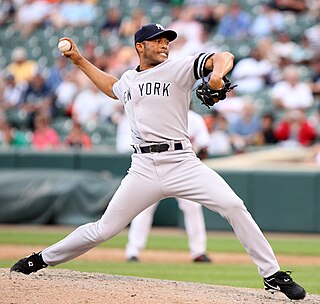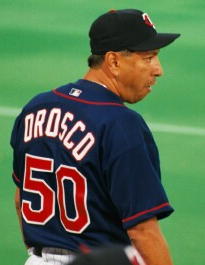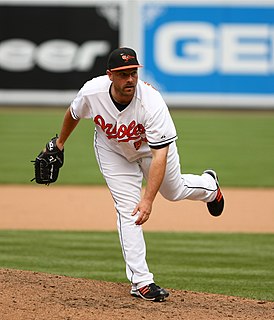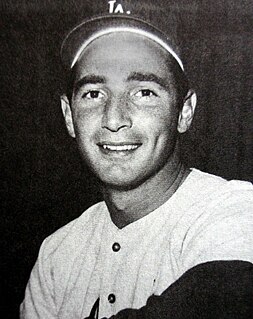
In baseball, a complete game (CG) is the act of a pitcher pitching an entire game without the benefit of a relief pitcher. A pitcher who meets this criterion will be credited with a complete game regardless of the number of innings played—pitchers who throw an entire official game that is shortened by rain will still be credited with a complete game, while starting pitchers who are relieved in extra innings after throwing nine or more innings will not be credited with a complete game. A starting pitcher who is replaced by a pinch hitter in the final half inning of a game will still be credited with a complete game.

Harry Leroy "Roy" Halladay III was an American professional baseball pitcher, who played in Major League Baseball (MLB) for the Toronto Blue Jays and Philadelphia Phillies between 1998 and 2013. His nickname, "Doc", was coined by Toronto Blue Jays announcer Tom Cheek, and was a reference to Wild West gunslinger Doc Holliday. An eight-time All-Star, Halladay was one of the most dominant pitchers of his era. Known for his outstanding durability, he led the league in complete games seven times, the most of any pitcher whose career began after 1945. He also led the league in strikeout-to-walk ratio five times and innings pitched four times.

In baseball, a save is credited to a pitcher who finishes a game for the winning team under certain prescribed circumstances. Most commonly a pitcher earns a save by entering in the ninth inning of a game in which his team is winning by three or fewer runs and finishing the game by pitching one inning without losing the lead. The number of saves or percentage of save opportunities successfully converted are oft-cited statistics of relief pitchers, particularly those in the closer role. The save statistic was created by journalist Jerome Holtzman in 1959 to "measure the effectiveness of relief pitchers" and was adopted as an official MLB statistic in 1969. The save has been retroactively measured for pitchers before that date. Mariano Rivera is MLB's all-time leader in regular-season saves with 652, while Francisco Rodríguez earned the most saves in a single season with 62 in 2008.

In baseball, a no-hitter is a game in which a team was not able to record a single hit through conventional means. Major League Baseball (MLB) officially defines a no-hitter as a completed game in which a team that batted in at least nine innings recorded no hits. A pitcher who prevents the opposing team from achieving a hit is said to have "thrown a no-hitter". In most cases, no-hitters are recorded by a single pitcher who throws a complete game; one thrown by two or more pitchers is a combined no-hitter.

Charles Gardner Radbourn, nicknamed "Old Hoss", was an American professional baseball pitcher who played 12 seasons in Major League Baseball (MLB). He played for Buffalo (1880), Providence (1881–1885), Boston (1886–1889), Boston (1890), and Cincinnati (1891).

In baseball, a starting pitcher or starter is the first pitcher in the game for each team. A pitcher is credited with a game started if they throw the first pitch to the opponent's first batter of a game. Starting pitchers are expected to pitch for a significant portion of the game, although their ability to do this depends on many factors, including effectiveness, stamina, health, and strategy.

In baseball and softball, a relief pitcher or reliever is a pitcher who enters the game after the starting pitcher is removed due to injury, ineffectiveness, fatigue, ejection, or for other strategic reasons, such as inclement weather delays or pinch hitter substitutions. Relief pitchers are further divided informally into various roles, such as closers, setup men, middle relief pitchers, left/right-handed specialists, and long relievers. Whereas starting pitchers usually rest several days before pitching in a game again due to the number of pitches thrown, relief pitchers are expected to be more flexible and typically pitch more games but with fewer innings pitched. A team's staff of relievers is normally referred to metonymically as a team's bullpen, which refers to the area where the relievers sit during games, and where they warm-up prior to entering the game.

In baseball, a left-handed specialist is a relief pitcher who throws left-handed and specializes in pitching to left-handed batters, weak right-handed batters, and switch-hitters who bat poorly right-handed. Because baseball practices permanent substitution, these pitchers frequently pitch to a very small number of batters in any given game, and rarely pitch to strictly right-handed batters. Most Major League Baseball (MLB) teams have several left-handed pitchers on their rosters, at least one of whom is a left-handed specialist. A left-handed specialist is sometimes called a LOOGY, coined by John Sickels, and may be used pejoratively.

In baseball, a setup man is a relief pitcher who regularly pitches before the closer. They commonly pitch the eighth inning, with the closer pitching the ninth.

Carlos Alberto Zambrano Matos, nicknamed "Big Z" or "El Toro", is a Venezuelan former professional baseball pitcher. He played in Major League Baseball (MLB) from 2001 to 2012 for the Chicago Cubs and Miami Marlins. Zambrano, who stands 6 feet 4 inches (1.93 m) and weighs 275 pounds (125 kg), was signed by the Cubs as a free agent in 1997 and made his debut in 2001. After being used in both starting and relief duties, he enjoyed his first full season as a starter in 2003, finishing with a 13–11 record, 168 strikeouts and a 3.11 ERA.

Félix Abraham Hernández García, nicknamed "King Félix", is a Venezuelan professional baseball pitcher who is a free agent. He previously played in Major League Baseball (MLB) for the Seattle Mariners from 2005 through 2019.

The Neyer/James Guide to Pitchers (ISBN 0-7432-6158-5) is a non-fiction baseball reference book, written by Rob Neyer and Bill James and published by Simon & Schuster in June 2004. In the text on its dust jacket, it bills itself as a "comprehensive guide" to "pitchers, the pitches they throw, and how they throw them".
Rany Jazayerli, a Chicago-area dermatologist, is a co-founder of and writer for Baseball Prospectus. He developed the statistical concept of Pitcher Abuse Points (PAP), which relates to high pitch counts in baseball.

This is an alphabetical list of selected unofficial and specialized terms, phrases, and other jargon used in baseball, along with their definitions, including illustrative examples for many entries.

In baseball, a closing pitcher, more frequently referred to as a closer, is a relief pitcher who specializes in getting the final outs in a close game when his team is leading. The role is often assigned to a team's best reliever. Before the 1990s, pitchers in similar roles were referred to as a fireman, short reliever, and stopper. A small number of closers have won the Cy Young Award. Eight closers have been inducted into the Baseball Hall of Fame: Dennis Eckersley, Rollie Fingers, Goose Gossage, Trevor Hoffman, Mariano Rivera, Lee Smith, Bruce Sutter and Hoyt Wilhelm.

Power pitcher is a term in baseball for a pitcher who relies on pitch velocity at the expense of accuracy. Power pitchers usually record a high number of strikeouts, and statistics such as strikeouts per 9 innings pitched are common measures of power. An average pitcher strikes out about 5 batters per nine innings while a power pitcher will often strike out one or more every inning. The prototypical power pitcher is National Baseball Hall of Fame member, Nolan Ryan, who struck out a Major League Baseball record 5,714 batters in 5,386 innings. Ryan recorded seven no-hitters, appeared in eight Major League Baseball All-Star Games but also holds the record for most walks issued (2,795).
The Providence Grays went 84–28 during the 1884 season to win the National League championship. The team started out with two main pitchers, Charles "Old Hoss" Radbourn and Charlie Sweeney. After Sweeney jumped to the Union Association in mid-season, Radbourn pitched most of the Grays' remaining games and led the team to the pennant. Radbourn won 60 games by himself, setting a Major League Baseball record that has never been broken.

In Major League Baseball, a shutout refers to the act by which a single pitcher pitches a complete game and does not allow the opposing team to score a run. If two or more pitchers combine to complete this act, no pitcher is awarded a shutout, although the team itself can be said to have "shut out" the opposing team.
















